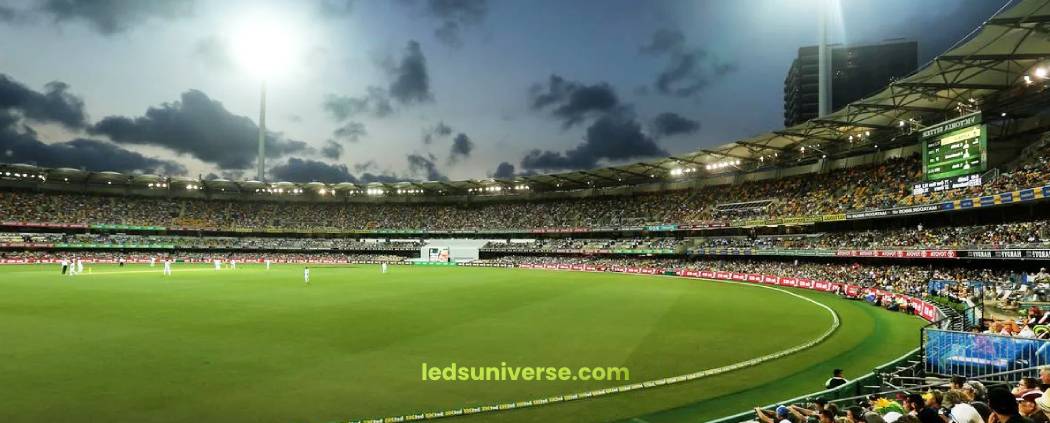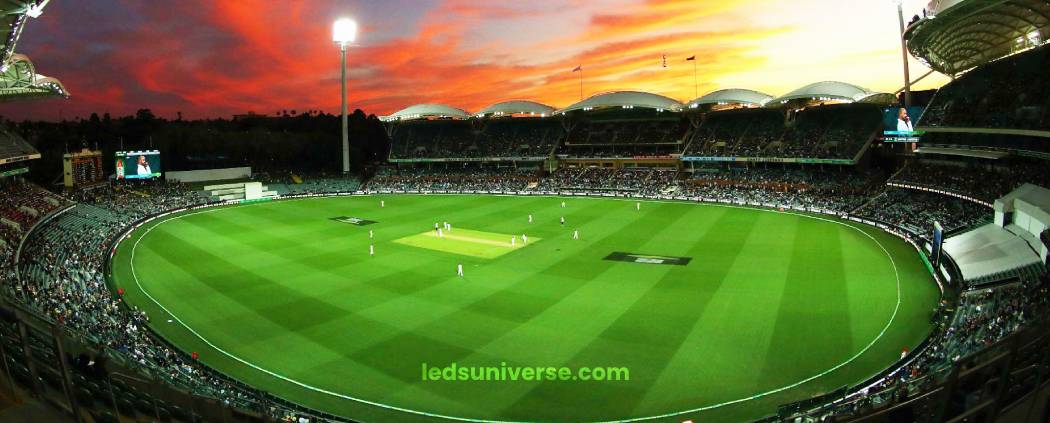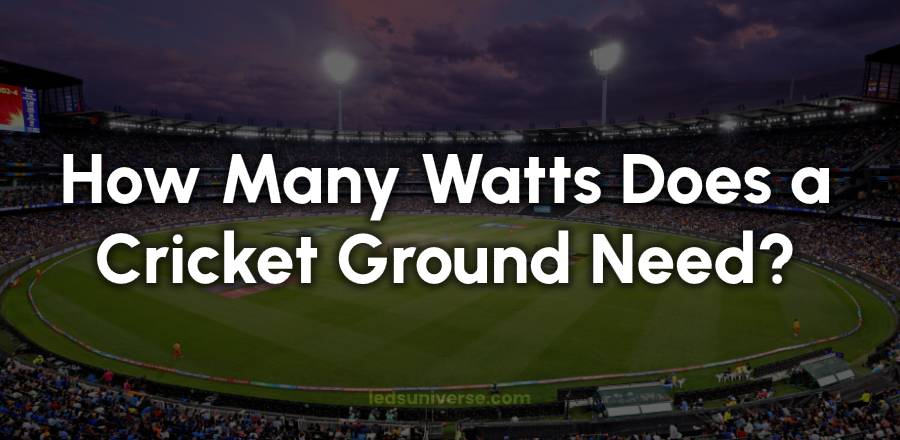Table of Contents
ToggleUnderstanding the Basics of Cricket Field Lighting
Cricket, a sport enjoyed in many countries, is increasingly being played under artificial lights. Night matches, day-night formats, and practice sessions after sunset have all contributed to a growing demand for well-lit grounds. Proper lighting ensures visibility for players, umpires, and spectators, and helps broadcasting teams deliver high-definition visuals to viewers worldwide.
The wattage needed to light a cricket ground depends on a mix of factors including the size of the field, the level of competition, type of luminaires used, mounting height, and uniformity requirements. Different formats of the game and different venues—whether small practice nets or international stadiums—require varying lighting setups.
Dimensions of a Cricket Ground and Its Impact on Lighting
The area to be illuminated greatly influences the power requirement. A standard cricket field, as per international regulations, can have a diameter ranging between 137 to 150 meters. This large playing surface needs high-mast lighting systems capable of casting even and sufficient illumination across the entire area, including the boundary lines and pitch.
When calculating the wattage requirement, the entire area within the playing boundary plus a few extra meters around the field is considered. The larger the area, the more powerful and numerous the lighting fixtures need to be to maintain visual clarity and brightness across the surface.
Lighting Standards for Different Levels of Play

Local or Recreational Grounds
For small clubs or recreational cricket played at night, the lighting requirements are modest. These grounds can function well with a lighting level of around 250 to 300 lux. With energy-efficient LED floodlights, a small ground may only need a system of around 40,000 to 60,000 total watts to provide adequate lighting for training or amateur matches.
These setups prioritize cost-efficiency and basic visibility. The lux level is sufficient for players to spot the ball and for umpires to make fair judgments. However, these setups may not be suitable for high-speed action or professional broadcasting.
Domestic Matches and Semi-Professional Grounds
Domestic leagues and semi-professional cricket matches demand improved lighting to accommodate higher performance levels and increased audience expectations. These venues typically require between 500 to 750 lux for playing areas, especially for evening matches.
The wattage requirement here ranges from 100,000 to 150,000 watts depending on the field size and lighting design. Mast height and spacing are adjusted to reduce shadow areas and enhance uniformity across the field. These setups often include emergency backup lighting to prevent interruptions during sudden power outages.
International Stadiums and Broadcast Matches
Lighting in international stadiums must meet stringent standards. The minimum lux level required for HDTV broadcasting is typically around 2000 lux for the main pitch and about 1500 lux for the outfield. These high lighting levels ensure clarity of fast-moving balls, eliminate shadows, and enhance the viewing experience for fans in the stadium and watching at home.
To achieve these lux levels, stadiums often require wattage outputs between 300,000 to 500,000 watts, or even more. These setups use high-performance LED floodlights, arranged on tall masts or rooftop mounts, ensuring even light distribution and controlled glare. The lighting infrastructure is also supported by intelligent control systems that adjust brightness levels depending on the match conditions.
Types of Lights Used in Cricket Grounds
Traditionally, cricket grounds relied on metal halide lamps for field illumination. These lamps offered bright white light and were widely available, making them the default choice for stadium lighting during much of the late 20th century. A standard metal halide floodlight with a 2000-watt rating typically produces around 180,000 lumens. However, they also come with drawbacks—long warm-up times, frequent maintenance, and significant energy loss due to heat generation.
Over the past decade, LED (Light Emitting Diode) technology has rapidly overtaken metal halide systems across both domestic and international venues. LEDs offer multiple advantages: they power up instantly, have lifespans exceeding 50,000 hours, and deliver light with greater precision. A 1000-watt LED floodlight can produce up to 160,000 lumens, offering nearly the same output as a 2000-watt metal halide while using only half the energy. This makes them more efficient not only in terms of power consumption but also in delivering directed, usable light to the playing area.
For example, a cricket stadium using 120 units of 1000-watt LED floodlights consumes around 120,000 watts. In comparison, a similar setup using 1500-watt metal halide lamps would consume 180,000 watts for the same light coverage—resulting in roughly 33% more energy used for a comparable outcome. Additionally, metal halides lose brightness over time due to lumen depreciation, whereas LEDs retain a high percentage of their initial output even after years of usage.
Another advantage of LED lighting is its ability to control the beam angle and direction. With beam angle options ranging from 15° (for focused light) to 120° (for wide dispersion), designers can tailor the lighting to cover specific zones of the field—pitch, outfield, and boundary areas—without wasting light in unintended areas. This precise control helps reduce light spill, skyglow, and glare, all of which are concerns in urban stadiums or environmentally sensitive areas.
High-performance LED floodlights often come with optical lenses and anti-glare shields. These additions are especially useful in cricket where the ball travels high in the air, and fielders must track it against a dark sky. Anti-glare optics reduce discomfort for players while improving visibility.
Some LED lighting systems now incorporate intelligent drivers and IoT integration. These systems allow real-time adjustment of brightness levels, color temperature control (from warm white to daylight white), and zonal activation. This level of flexibility makes LED systems ideal for venues that host multi-sport activities or events with varied lighting needs.

Lux Level and Uniformity Considerations
| Match Type | Pitch Lux Level | Outfield Lux Level |
|---|---|---|
| Recreational Play | 250–300 lux | 250–300 lux |
| Club-Level Matches | 500–750 lux | 300–500 lux |
| Domestic Competitions | 1000–1500 lux | 800–1000 lux |
| International Broadcast Events | 2000 lux | 1500 lux |
Lux level, defined as lumens per square meter, is the standard unit used to measure the intensity of illumination falling on a surface. In the context of cricket field lighting, lux measurements are not uniform across the entire playing area. Instead, they are specifically tailored to the functional demands of different zones. The pitch, being the central and most actively used part of the ground, demands higher illumination due to the rapid movement of the ball, the precision required by the players, and the visual clarity necessary for spectators and broadcasting. The outfield, while also active, requires slightly less intense lighting, but still must be consistently illuminated to maintain overall playability and visibility.
For venues hosting international cricket matches, the generally adopted standards recommend approximately 2000 lux for the pitch and about 1500 lux for the outfield. These levels ensure that high-speed gameplay is clearly visible under various conditions, including slow-motion replays and high-definition broadcasts. At the other end of the spectrum, local or recreational fields, which serve amateur or training purposes, typically operate within a lower range. In such settings, lux levels may vary from 250 to 500 depending on the field’s purpose and whether events are conducted under supervision, in the evening, or for casual recreational use. Between these two extremes lie club-level and domestic competition standards, which scale lux requirements proportionally based on field use, crowd size, and match significance.
Uniformity is a parallel concern when designing lighting layouts for cricket grounds. Unlike lux, which quantifies intensity, uniformity describes the evenness of light distribution across the playing surface. It is typically expressed as a ratio between the minimum lux value observed on the field and the average lux value. A uniformity ratio of 0.7 or higher is generally targeted for professional installations, indicating that lighting across the field does not dip below 70 percent of the average intensity. Such consistency is critical in eliminating visual discomfort for players, avoiding distracting bright spots or dark patches, and ensuring that televised footage captures consistent detail regardless of where play is taking place.
Achieving high uniformity requires a strategic arrangement of floodlights, both in terms of their location and how they are angled. In standard setups, lighting fixtures are mounted on tall masts that can range from 30 to 50 meters in height. Each mast may hold a set of 8 to 16 high-output LED floodlights, carefully positioned to overlap light beams and ensure seamless coverage of the entire field. This overlapping not only helps to eliminate areas of reduced brightness but also minimizes flicker and shadows that may interfere with player performance or viewer experience.
Modern cricket stadiums designed for high-end broadcasting adopt even more sophisticated methods to manage lux levels and uniformity. These venues often employ advanced lighting design software to simulate how light will behave under various environmental conditions, such as different times of day or changing weather. These simulations provide precise guidance on fixture placement, tilt angle, and the type of lens or reflector required. The resulting design maximizes the efficiency of each luminaire, ensuring that light is not only abundant but also directed exactly where it is needed without contributing to glare or light pollution.
The interplay between various lighting parameters contributes directly to uniformity outcomes. The height of the fixtures, the beam angle selected, the optical lens used, and even the symmetry of the fixture layout all influence how light spreads across the field. A well-designed system ensures that players at the edge of the boundary have the same visibility as those near the wicket, supporting fair play and enhancing the visual spectacle for audiences both in the stadium and watching remotely.
Importantly, creating optimal lux levels with excellent uniformity does not necessarily entail installing more fixtures. Instead, it calls for the deployment of high-efficiency luminaires that are positioned with precision. By investing in high-performance LED systems and relying on expert planning, cricket grounds can achieve lighting that is visually effective, energy-efficient, and well-suited for professional play. As a result, even with fewer fixtures, fields can maintain consistent brightness, reduce operational costs, and deliver a better overall experience for athletes, officials, and spectators alike.
Energy Efficiency and Power Management
While the total wattage provides an overview of the system’s power needs, managing that energy effectively is what helps reduce operational expenses. LED systems offer dimming options and programmable controls that can adjust brightness depending on the time of day or match format.
Many stadiums use smart systems that integrate with weather sensors or match schedules to optimize energy use. Motion sensors and time-based controls also assist in reducing electricity consumption during practice sessions or breaks.
Backup Power and Reliability Measures
Power disruptions can affect match schedules, especially during night events. To counter this, many stadiums include backup generators and Uninterruptible Power Supply (UPS) systems. These ensure continuous lighting during transitions and allow the game to proceed without delay.
Reliability is also improved through fixture redundancy, where multiple lights cover overlapping areas so that the failure of a single unit does not cause visible dark patches. Monitoring systems further assist by sending real-time alerts if any component malfunctions.
Case Examples from Real Stadiums
To better understand the wattage requirements and lighting strategies employed in cricket grounds, it is helpful to examine the systems used in some of the world’s most iconic stadiums. These examples provide real-world benchmarks for how lighting infrastructure supports international broadcasting standards, large-scale event operations, and player visibility under various match conditions.

Melbourne Cricket Ground (MCG)
One of the most recognized venues globally, the Melbourne Cricket Ground (MCG) in Australia, is a prime example of modern stadium lighting. As one of the largest cricket stadiums in the world with a seating capacity exceeding 100,000, the MCG utilizes a sophisticated LED floodlighting system distributed across multiple high-mast structures. The total installed lighting capacity exceeds 500,000 watts, with individual fixtures often rated at 1500 watts or higher. These lights are strategically placed on 85-meter masts around the stadium’s perimeter to ensure high lux levels and excellent uniformity across the pitch and outfield. The system is designed to support ultra-high-definition broadcast requirements, enabling the capture of sharp, shadow-free visuals even during fast-paced night matches. The lights are also zonally controllable, allowing different sections of the field to be independently lit based on the format or time of day.
Another example is Lord’s Cricket Ground in London, which blends tradition with innovation in its lighting approach. Lord’s features retractable floodlight towers, each housing high-efficiency LED fixtures with an estimated combined output exceeding 400,000 watts. These floodlights are designed to maintain a lighting level of approximately 2000 lux on the pitch and 1500 lux across the outfield, meeting the stringent requirements of the England and Wales Cricket Board and international broadcasting partners. The system uses advanced beam control optics that allow precise light distribution, reducing unwanted spill and minimizing skyglow in the urban setting of central London. This level of engineering enables Lord’s to maintain visual clarity for players and broadcasters while preserving the architectural integrity and sightlines of the historic venue.
The Narendra Modi Stadium in Ahmedabad, India, currently the largest cricket stadium in the world by capacity, also features a state-of-the-art lighting system tailored for large-scale events and nighttime matches. Rather than traditional high-mast lighting, this venue employs an innovative circular ring lighting system integrated into the roof structure. This approach evenly distributes light over the entire playing surface while reducing glare. The stadium’s lighting infrastructure includes more than 600 LED fixtures, each with a power rating between 1000 and 1500 watts, contributing to an estimated total wattage of over 600,000. This setup provides the illumination necessary to support multi-camera coverage, aerial shots, and 4K broadcasting for domestic and international matches.
Similarly, the Dubai International Cricket Stadium offers a unique lighting system known as “Ring of Fire.” Unlike conventional mast lighting, the stadium uses a full circular arrangement of lights around the stadium’s roof. This design creates uniform lighting with virtually no shadows on the field. It consists of over 350 LED lights rated between 1000 and 1200 watts each, totaling approximately 400,000 watts in power consumption. The lighting is designed to handle high-definition television coverage, accommodate day-night matches, and support the intense glare resistance required for limited-overs formats such as T20.
Across these examples, it becomes evident that modern cricket lighting is not only about installing powerful lights. Instead, it is a calculated engineering effort that balances wattage, fixture distribution, and control technology. Each stadium’s lighting design is based on a combination of seating layout, field dimensions, environmental considerations, and broadcasting requirements. The wattage alone does not dictate performance; rather, it is the synergy between wattage, fixture efficiency, mounting strategy, and digital control systems that ensures optimum field conditions.
The case studies from these international stadiums underscore the trend toward energy-efficient, high-output LED solutions combined with advanced lighting design principles. Whether the lighting infrastructure is built into towering masts or concealed within architectural features, the primary objective remains the same: to provide consistent, glare-free illumination that meets the highest standards of professional cricket.
Conclusion
Lighting a cricket field is a detailed undertaking that requires careful wattage planning based on the size of the ground, level of play, and the type of fixtures used. While smaller fields might operate comfortably within 40,000 to 60,000 watts, international venues can go beyond 500,000 watts to ensure optimal visibility and broadcast quality.
Choosing energy-efficient LED fixtures, setting appropriate lux levels, and implementing smart control systems help optimize both the performance and sustainability of the lighting setup. As cricket continues to grow as a global sport, the demand for well-lit grounds will only increase, pushing lighting design to new heights in both technology and creativity.
